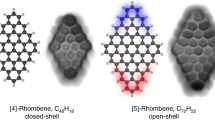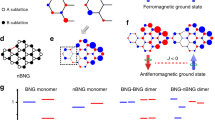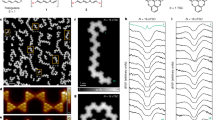Abstract
Open-shell nanographenes exhibit unconventional π-magnetism arising from topological frustration or strong electron–electron interaction. However, conventional design approaches are typically limited to a single magnetic origin, which can restrict the number of correlated spins or the type of magnetic ordering in open-shell nanographenes. Here we present a design strategy that combines topological frustration and electron–electron interactions to fabricate a large fully fused ‘butterfly’-shaped tetraradical nanographene on Au(111). We employ bond-resolved scanning tunnelling microscopy and spin-excitation spectroscopy to resolve the molecular backbone and reveal the strongly correlated open-shell character, respectively. This nanographene contains four unpaired electrons with both ferromagnetic and anti-ferromagnetic interactions, harbouring a many-body singlet ground state and strong multi-spin entanglement, which is well described by many-body calculations. Furthermore, we study the magnetic properties and spin states in the nanographene using a nickelocene magnetic probe. The ability to imprint and characterize many-body strongly correlated spins in polyradical nanographenes paves the way for future advancements in quantum information technologies.

This is a preview of subscription content, access via your institution
Access options
Access Nature and 54 other Nature Portfolio journals
Get Nature+, our best-value online-access subscription
$29.99 / 30 days
cancel any time
Subscribe to this journal
Receive 12 print issues and online access
$259.00 per year
only $21.58 per issue
Buy this article
- Purchase on Springer Link
- Instant access to full article PDF
Prices may be subject to local taxes which are calculated during checkout




Similar content being viewed by others
Data availability
All data are available in the manuscript or the supplementary information. The SPM, spectra data and theoretical calculation results are available in the Zenodo repository at https://doi.org/10.5281/zenodo.8365320.
References
de Oteyza, D. G. & Frederiksen, T. Carbon-based nanostructures as a versatile platform for tunable π-magnetism. J. Phys. Condens. Matter 34, 443001 (2022).
Song, S. et al. On-surface synthesis of graphene nanostructures with π-magnetism. Chem. Soc. Rev. 50, 3238–3262 (2021).
Mishra, S. et al. Large magnetic exchange coupling in rhombus-shaped nanographenes with zigzag periphery. Nat. Chem. 13, 581–586 (2021).
Mishra, S. et al. Topological frustration induces unconventional magnetism in a nanographene. Nat. Nanotechnol. 15, 22–28 (2020).
Hieulle, J. et al. On‐surface synthesis and collective spin excitations of a triangulene‐based nanostar. Angew. Chem. Int. Ed. 60, 25224–25229 (2021).
Mishra, S. et al. Synthesis and characterization of π-extended triangulene. J. Am. Chem. Soc. 141, 10621–10625 (2019).
Zeng, Z. et al. Pro-aromatic and anti-aromatic π-conjugated molecules: an irresistible wish to be diradicals. Chem. Soc. Rev. 44, 6578–6596 (2015).
Pavliček, N. et al. Synthesis and characterization of triangulene. Nat. Nanotechnol. 12, 308–311 (2017).
Mishra, S. et al. Observation of fractional edge excitations in nanographene spin chains. Nature 598, 287–292 (2021).
Zheng, Y. et al. Designer spin order in diradical nanographenes. Nat. Commun. 11, 6076 (2020).
Su, X. et al. Atomically precise synthesis and characterization of heptauthrene with triplet ground state. Nano Lett. 20, 6859–6864 (2020).
Sun, Z., Ye, Q., Chi, C. & Wu, J. Low band gap polycyclic hydrocarbons: from closed-shell near infrared dyes and semiconductors to open-shell radicals. Chem. Soc. Rev. 41, 7857–7889 (2012).
Zeng, W. & Wu, J. Open-shell graphene fragments. Chem 7, 358–386 (2021).
Xiang, Q. et al. Stable olympicenyl radicals and their π-dimers. J. Am. Chem. Soc. 142, 11022–11031 (2020).
Guo, Y. et al. π-Extended doublet open-shell graphene fragments exhibiting one-dimensional chain stacking. J. Am. Chem. Soc. 144, 2095–2100 (2022).
Yazyev, O. V. & Katsnelson, M. Magnetic correlations at graphene edges: basis for novel spintronics devices. Phys. Rev. Lett. 100, 047209 (2008).
Su, J. et al. Atomically precise bottom-up synthesis of π-extended [5] triangulene. Sci. Adv. 5, eaav7717 (2019).
Mishra, S. et al. Collective all‐carbon magnetism in triangulene dimers. Angew. Chem. Int. Ed. 132, 12139–12145 (2020).
Li, J. et al. Uncovering the triplet ground state of triangular graphene nanoflakes engineered with atomic precision on a metal surface. Phys. Rev. Lett. 124, 177201 (2020).
Wang, T. et al. Aza-triangulene: on-surface synthesis and electronic and magnetic properties. J. Am. Chem. Soc. 144, 4522–4529 (2022).
Mishra, S. et al. Synthesis and characterization of [7] triangulene. Nanoscale 13, 1624–1628 (2021).
Su, J. et al. On-surface synthesis and characterization of [7] triangulene quantum ring. Nano Lett. 21, 861–867 (2020).
Turco, E. et al. Observation of the magnetic ground state of the two smallest triangular nanographenes. JACS Au 3, 1358–1364 (2023).
Ruffieux, P. et al. On-surface synthesis of graphene nanoribbons with zigzag edge topology. Nature 531, 489–492 (2016).
Blackwell, R. E. et al. Spin splitting of dopant edge state in magnetic zigzag graphene nanoribbons. Nature 600, 647–652 (2021).
Wen, E. C. H. et al. Magnetic interactions in substitutional core-doped graphene nanoribbons. J. Am. Chem. Soc. 144, 13696–13703 (2022).
Sanz, S. et al. Spin-polarizing electron beam splitter from crossed graphene nanoribbons. Phys. Rev. Lett. 129, 037701 (2022).
Wang, D. et al. Twisted bilayer zigzag-graphene nanoribbon junctions with tunable edge states. Nat. Commun. 14, 1018 (2023).
Ovchinnikov, A. A. Multiplicity of the ground state of large alternant organic molecules with conjugated bonds: (Do organic ferromagnetics exist?). Theor. Chim. Acta 47, 297–304 (1978).
Lieb, E. H. Two theorems on the Hubbard model. Phy. Rev. Lett. 62, 1201 (1989).
Wang, W. L., Yazyev, O. V., Meng, S. & Kaxiras, E. Topological frustration in graphene nanoflakes: magnetic order and spin logic devices. Phys. Rev. Lett. 102, 157201 (2009).
Biswas, K. et al. Steering large magnetic exchange coupling in nanographenes near the closed-shell to open-shell transition. J. Am. Chem. Soc. 145, 2968–2974 (2023).
González‐Herrero, H. et al. Atomic scale control and visualization of topological quantum phase transition in π‐conjugated polymers driven by their length. Adv. Mater. 33, 2104495 (2021).
Fajtlowicz, S., John, P. E. & Sachs, H. On maximum matchings and eigenvalues of benzenoid graphs. Croat. Chem. Acta 78, 195–201 (2005).
Ortiz, R. et al. Exchange rules for diradical π-conjugated hydrocarbons. Nano Lett. 19, 5991–5997 (2019).
Schüler, M., Rösner, M., Wehling, T., Lichtenstein, A. & Katsnelson, M. Optimal Hubbard models for materials with nonlocal Coulomb interactions: graphene, silicene, and benzene. Phys. Rev. Lett. 111, 036601 (2013).
Malrieu, J.-P. & Trinquier, G. Can a topological approach predict spin-symmetry breaking in conjugated hydrocarbons? J. Phys. Chem. A 120, 9564–9578 (2016).
Sánchez-Grande, A. et al. Unravelling the open-shell character of peripentacene on Au (111). J. Phys. Chem. Lett. 12, 330–336 (2020).
Biswas, K. et al. Synthesis and characterization of peri‐heptacene on a metallic surface. Angew. Chem. Int. Ed. 134, e202114983 (2022).
Guo, Y., Sivalingam, K., Valeev, E. F. & Neese, F. SparseMaps—a systematic infrastructure for reduced-scaling electronic structure methods. III. Linear-scaling multireference domain-based pair natural orbital N-electron valence perturbation theory. J. Chem. Phys. 144, 094111 (2016).
Truhlar, D. G., Hiberty, P. C., Shaik, S., Gordon, M. S. & Danovich, D. Orbitals and the interpretation of photoelectron spectroscopy and (e, 2e) ionization experiments. Angew. Chem. Int. Ed. 131, 12460–12466 (2019).
Ortiz, J. Dyson-orbital concepts for description of electrons in molecules. J. Chem. Phys. 153, 070902 (2020).
Ormaza, M. et al. Efficient spin-flip excitation of a nickelocene molecule. Nano Lett. 17, 1877–1882 (2017).
Czap, G. et al. Probing and imaging spin interactions with a magnetic single-molecule sensor. Science 364, 670–673 (2019).
Verlhac, B. et al. Atomic-scale spin sensing with a single molecule at the apex of a scanning tunneling microscope. Science 366, 623–627 (2019).
Wäckerlin, C. et al. Role of the magnetic anisotropy in atomic-spin sensing of 1D molecular chains. ACS Nano 16, 16402–16413 (2022).
Lombardi, F. et al. Quantum units from the topological engineering of molecular graphenoids. Science 366, 1107–1110 (2019).
Torbrügge, S., Schaff, O. & Rychen, J. Application of the KolibriSensor to combined atomic-resolution scanning tunneling microscopy and noncontact atomic-force microscopy imaging. J. Vac. Sci. Technol. B 28, C4E12–C14E20 (2010).
Neese, F. The ORCA program system. Wiley Interdiscip. Rev. Comput. Mol. Sci. 2, 73–78 (2012).
Brabec, J. et al. Massively parallel quantum chemical density matrix renormalization group method. J. Comput. Chem. 42, 534–544 (2021).
Acknowledgements
J. Lu acknowledges the support from Ministry of Education (MOE) grants (MOE T2EP50121-0008, MOE-T2EP10221-0005 and MOE-T2EP10123-0004), and National Research Foundation (NRF), Prime Minister’s Office, Singapore, under the Competitive Research Program Award (NRF-CRP29-2022-0004), Agency for Science, Technology and Research (A*STAR) under its Advanced Manufacturing and Engineering Individual Research Grants (AME IRG) grant (project 715 no. M21K2c0113). This work was supported by Science and Technology Project of Jiangsu Province, grant number BZ2022056. We acknowledge support from the CzechNanoLab Research Infrastructure supported by MEYS CR (LM2023051) and the Grant Agency of Czech Republic (GACR) project no. 23-05486 S. J.W. acknowledges the financial support from an A*STAR AME IRG grant (A20E5c0089) and NRF Investigatorship award (NRF-NRFI05-2019-0005). S.S. acknowledges the support from A*STAR under its AME Young Individual Research Grants (YIRG) grant (M22K3c0094). This work was supported by the Czech Ministry of Education, Youth and Sports from the Large Infrastructures for Research, Experimental Development and Innovations project ‘IT4 Innovations National Supercomputing Center–LM2015070’, and the Computational Chemical Sciences Program of the US Department of Energy, Office of Science, Basic Energy Science (BES), Chemical Sciences, Geosciences and Biosciences Division in the Center for Scalable and Predictive methods for Excitations and Correlated phenomena (SPEC) at Pacific Northwest National Laboratory (PNNL).
Author information
Authors and Affiliations
Contributions
J. Lu supervised the project. S.S., J.W. and J. Lu. conceived and designed the experiments. L.V. and P.J. conceived the theoretical studies. S.S., H.Y. and M.T. performed the on-surface synthesis and LT–STM measurements. A.P.S., O.S. and P.J. performed the IETS measurements with NiCp2 tip. G.L. and J.W. performed the organic synthesis of the precursor. A.M., L.V., D.S., M.K., Q.C., S.E., J.B. and P.J. performed the theoretical calculations. J. Li helped with the data presentation. S.S., P.J. and J. Lu. wrote the manuscript with input from all authors. All authors contributed to the scientific discussion.
Corresponding authors
Ethics declarations
Competing interests
The authors declare no competing interests.
Peer review
Peer review information
Nature Chemistry thanks Ganna Gryn’ova, Shigeki Kawai and the other, anonymous, reviewer(s) for their contribution to the peer review of this work.
Additional information
Publisher’s note Springer Nature remains neutral with regard to jurisdictional claims in published maps and institutional affiliations.
Supplementary information
Supplementary Information
Supplementary Scheme 1, Figs. 1–10, Tables 1–4 and discussion.
Rights and permissions
Springer Nature or its licensor (e.g. a society or other partner) holds exclusive rights to this article under a publishing agreement with the author(s) or other rightsholder(s); author self-archiving of the accepted manuscript version of this article is solely governed by the terms of such publishing agreement and applicable law.
About this article
Cite this article
Song, S., Pinar Solé, A., Matěj, A. et al. Highly entangled polyradical nanographene with coexisting strong correlation and topological frustration. Nat. Chem. (2024). https://doi.org/10.1038/s41557-024-01453-9
Received:
Accepted:
Published:
DOI: https://doi.org/10.1038/s41557-024-01453-9



